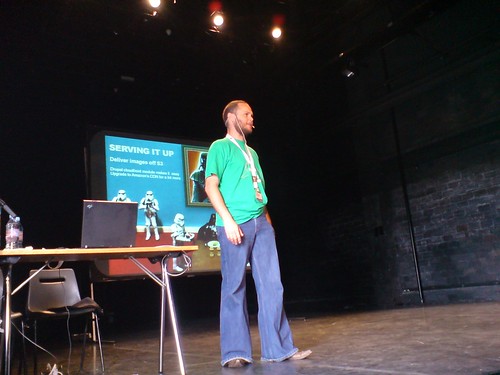LIVE at DrupalCon Paris 2009: How I learned to stop worrying and love the cloud
Session: Dr Clonelove: How I learned to stop worrying and love the cloud
Speaker: Peter Brownell, Co-Founder of School Of Everything, a Drupal based start-up in London. He is also a Director of Code Positive, and has been involved in the London Drupal Community for many years.
Notes
MySQL proxy changes the game.
“Clustering involves very high documentation. We run three servers. The idea is to move to small instances of dataases. Amazon gives you two main cluster machines. Large instances are 4 times more expensive than the small one. “
“When we began, it was obvious nothing was persistent.”
Handling failures
If your machine cannot be reconfigured, it can’t be in a cloud. You need to know how your machine was set up. Do things well. Assume that any part of the cloud can die.
- How do we go about reconfiguring that?
- Be able to rebuild from backups.
- Document and blog.
- Fire drill – practice makes perfect.
Rebuild debian host. Rebuild Drupal site. Drupal’s easy to rebuild. In emergencies, put in on a single server and temporarily disable some admin stuff that you don’t need; and then put it in front of a proxy.
Cloud City
Never have faith in just one ally. Set up a base off the cloud. Keep a backup on the ground. Monitor from the outside. Mail smarthost to avoid auto greylisting.
Foreseeing problems
Monitor as much as possible. Don’t trust anything. Look for clues for where problems arise. Do capacity planning. “We used Nagios and Munin”.
Hardware
The physical world moves a little slower. Virtual machines are cheap but you need to plan. Configure one original and make many copies, in multiple zones. Only pay for the time you use. It’s not two of everything always, it’s a spare when you need it.
The pieces putting the cluster together
- How safe is your data on the storage? “For the first month, we ran our MySQL database on EC2.
- Write to S3, read from local DB.
- Elastic Block Store – EBS.
- Point-in-time snapshots.
Clone 2 Clone Filesystem
- Avoid dependencies
- ClusterFS sync files instantly
- Primary webserver uses persistent storage
- Deliver images off S3. Drupal cloudfront modules makes it easy. Upgrade to Amazon’s CDN for a bit more.
- Round Robin DNS is a cheap solution for load balancing.
Summary
Cloud forces best practice. No time for slacker sysadmins!
Avoid dependencies. Work backwards
Document!
0 Comments
Welcome to my blog, where I write about art, tech and social change
- Design (4)
- Film (2)
- Interactive Art (1)
- News (1)
- Photography (3)
- The Struggle (1)
- The Web (2)
- Web Development (5)
- Writings (1)
Sites I Read
-
For people who make websites
-
Independent news and analysis from Malaysia
-
A great source on Middle East politics and war in spite of its name
-
A blog about politics and the arts
-
Dedicated to clever and innovative trends of art and design in activism
-
The newspaper of the NYC independent media center
-
International Socialism journal
A quarterly journal on socialist theory
-
A foot in the Malaysian arts scene
-
Good Art + Good Work = Better World
-
Alternative Malaysian news
-
The Monthly Review Magazine
-
Socialist magazine based in the UK
-
Ideas, opinions, thoughts
